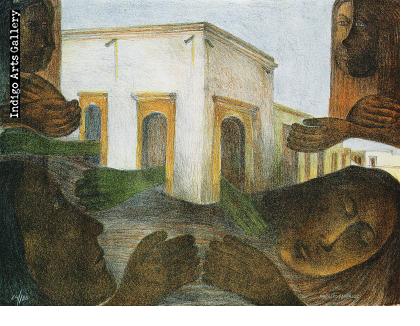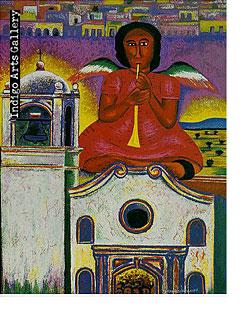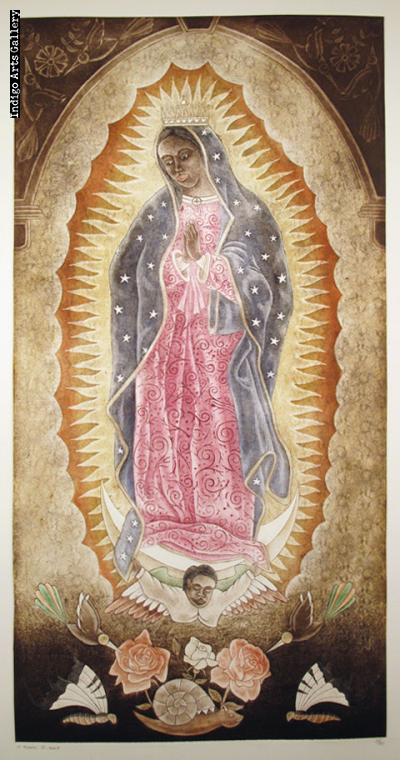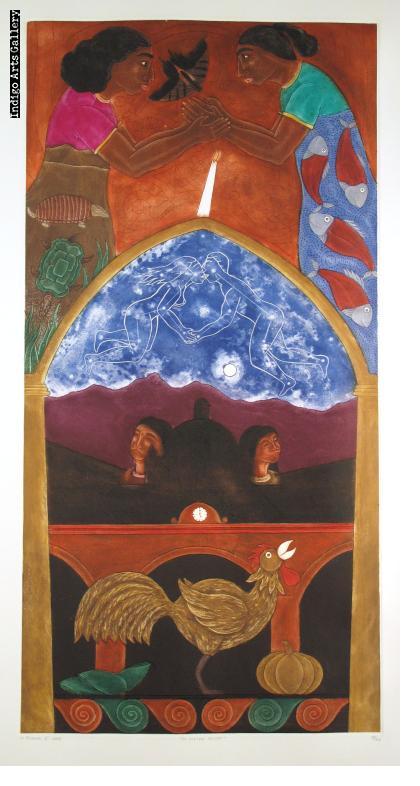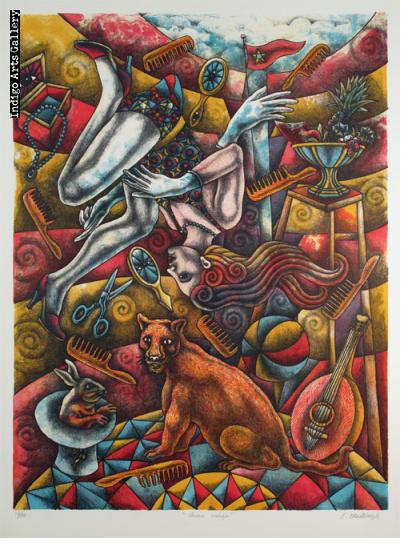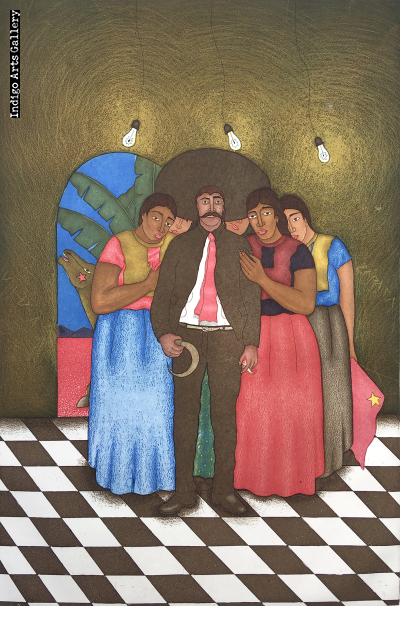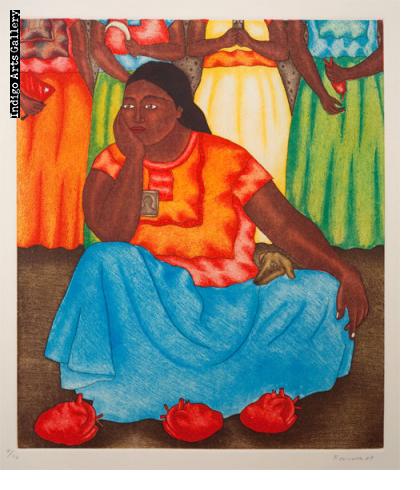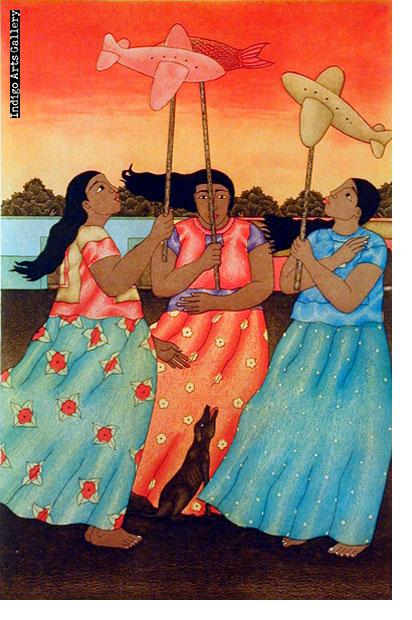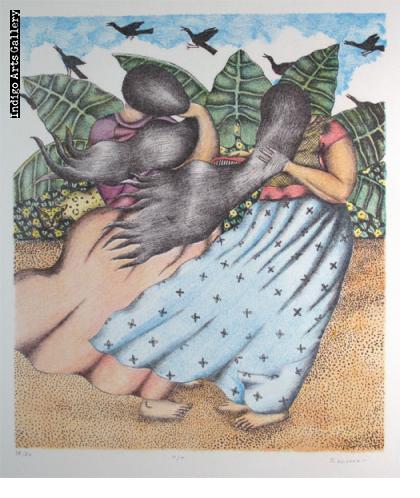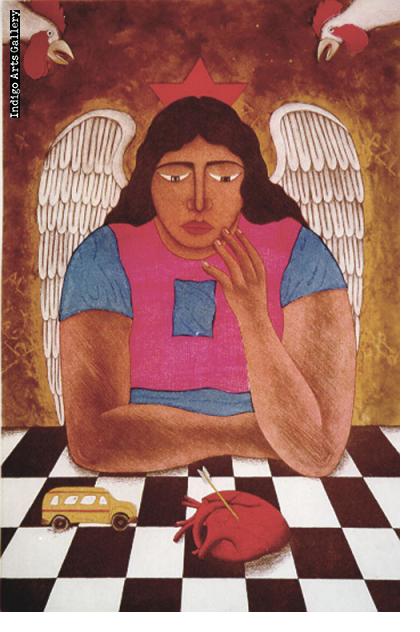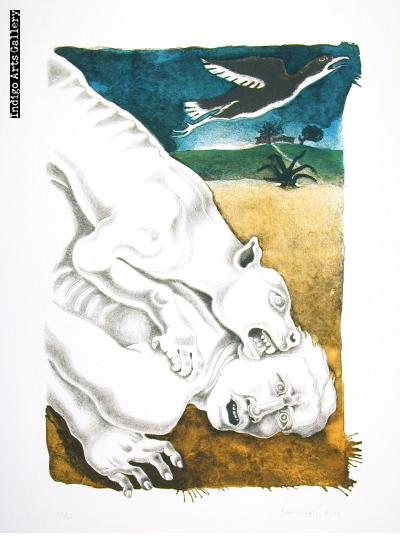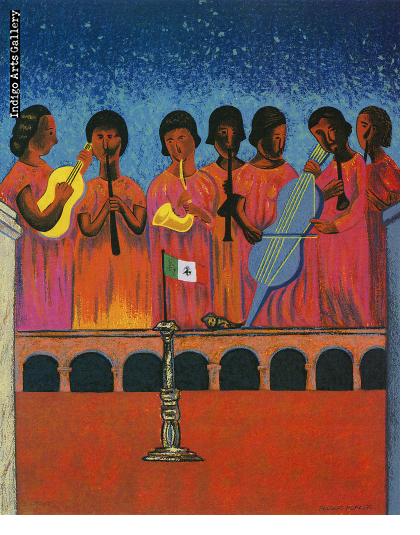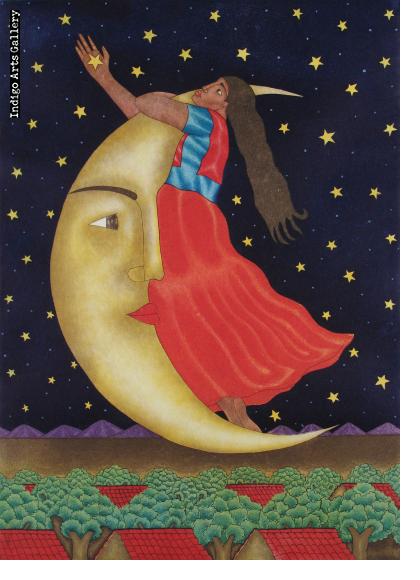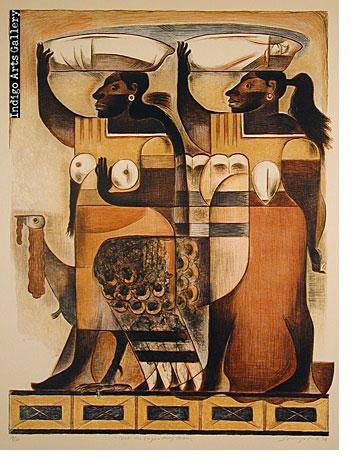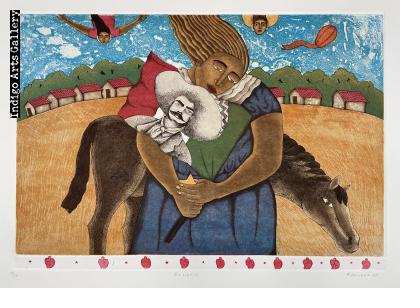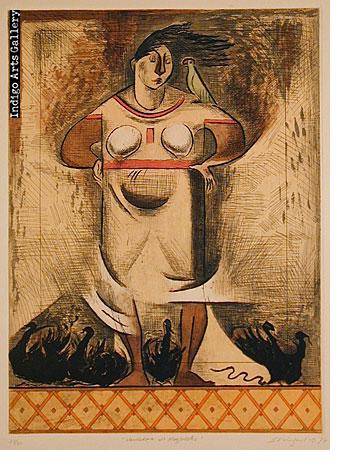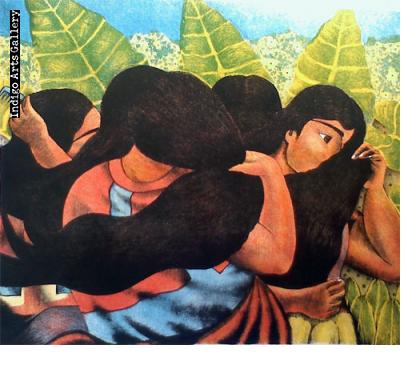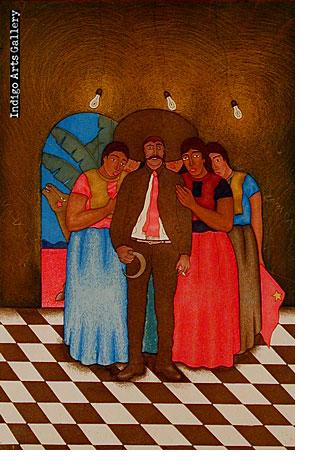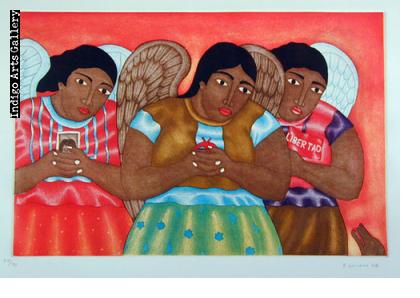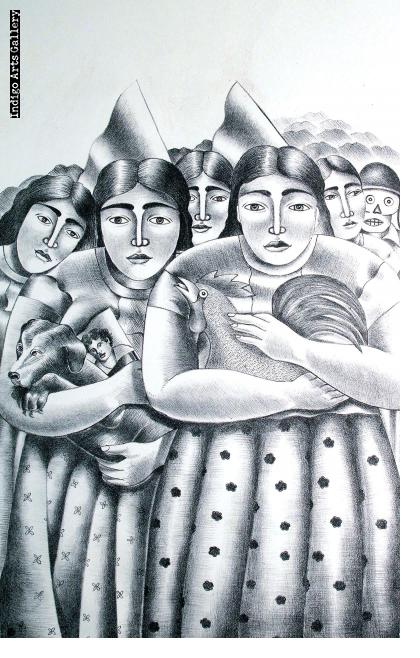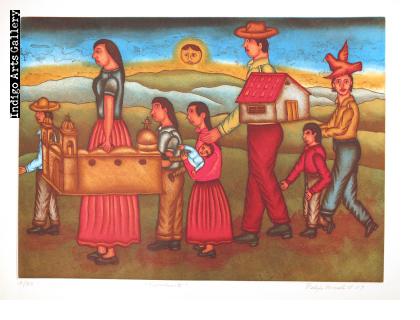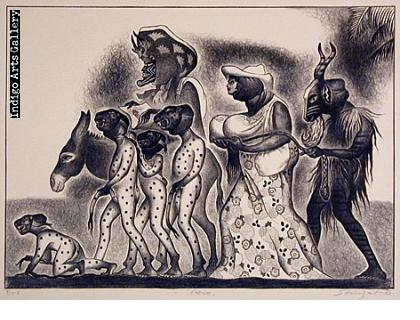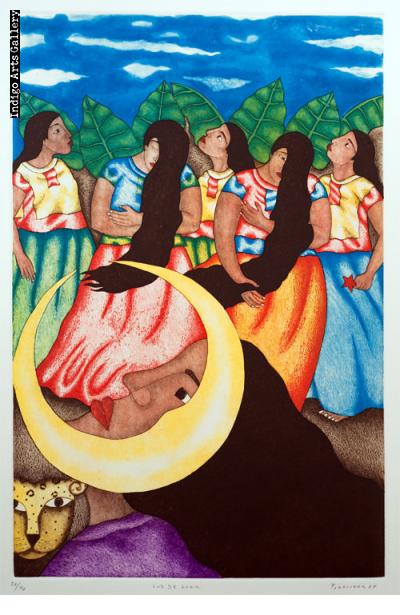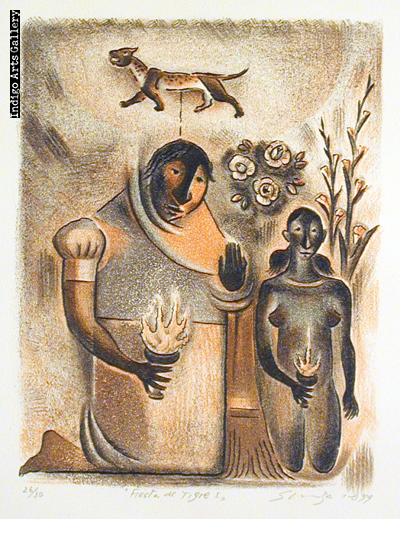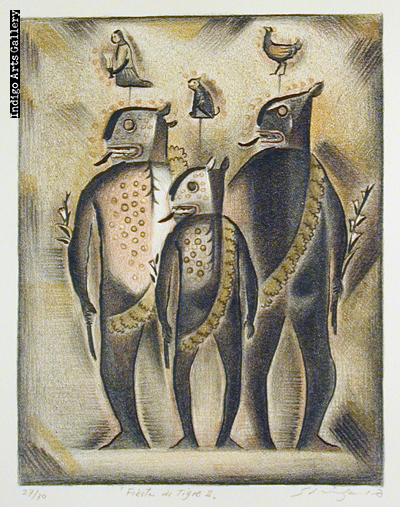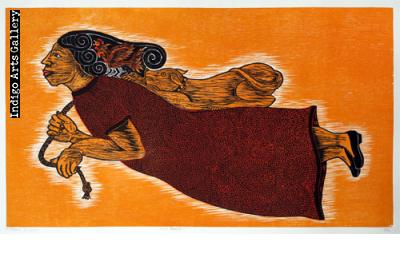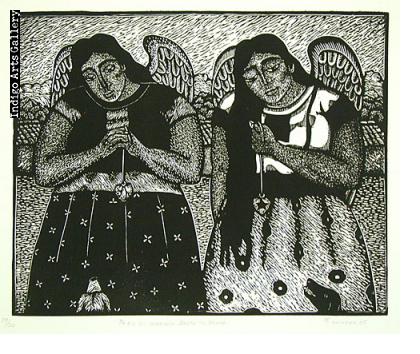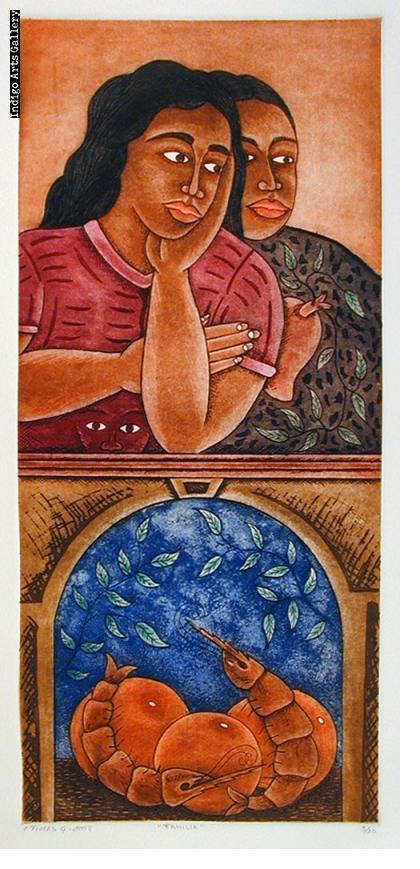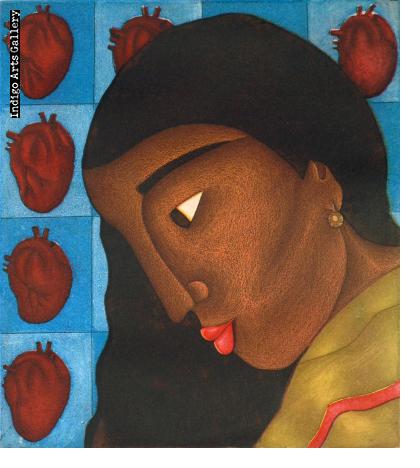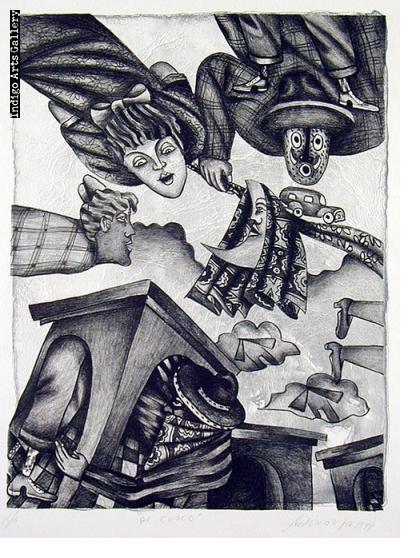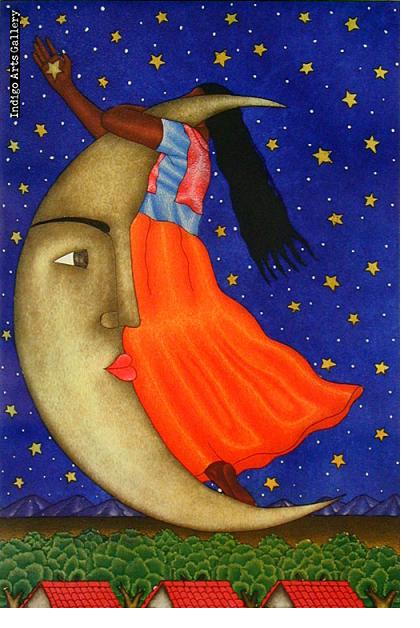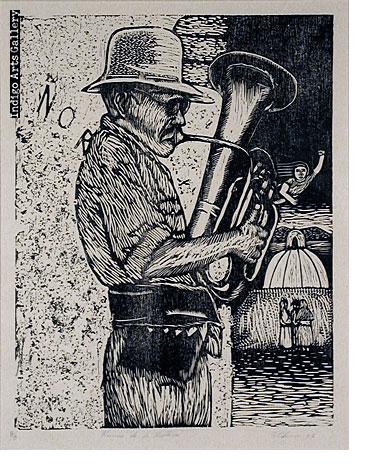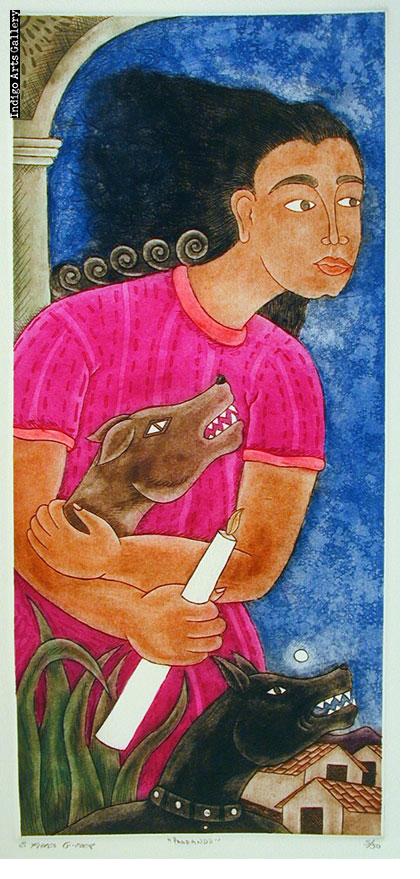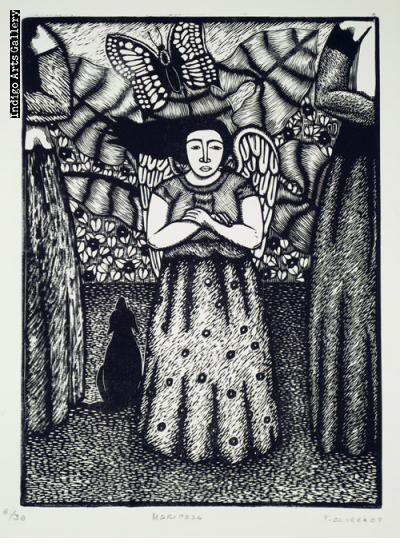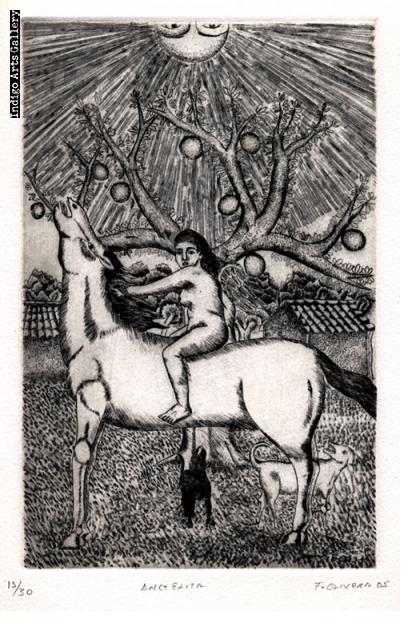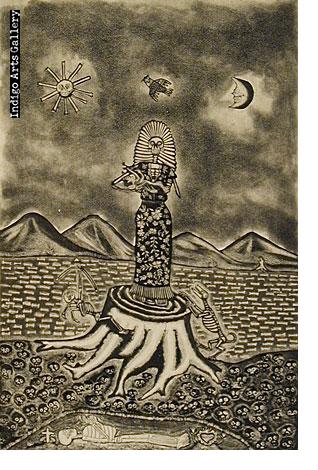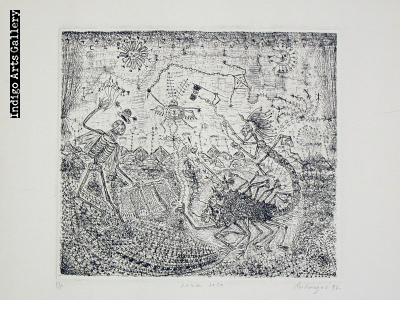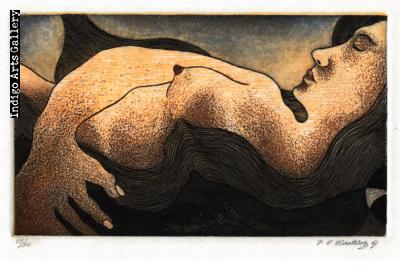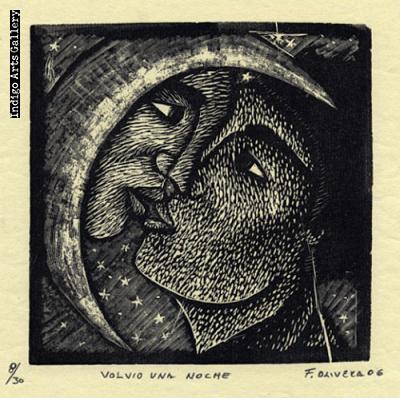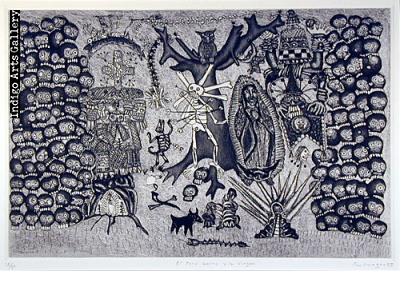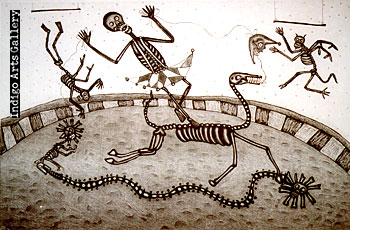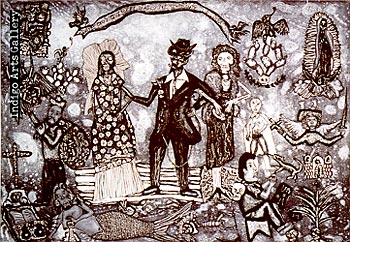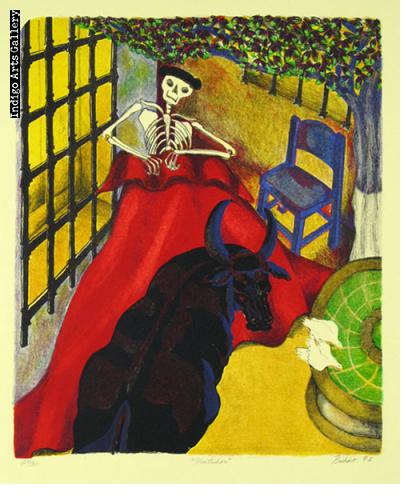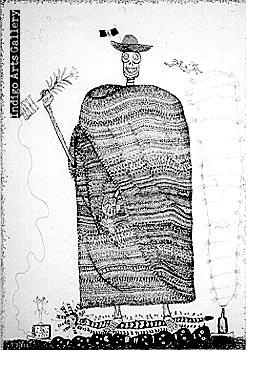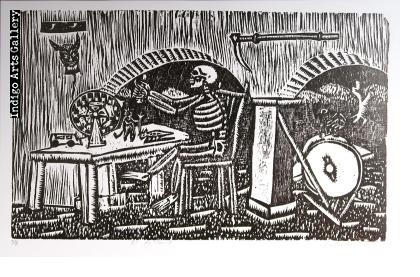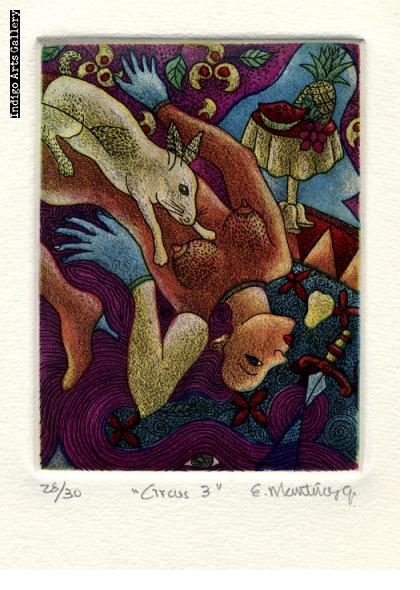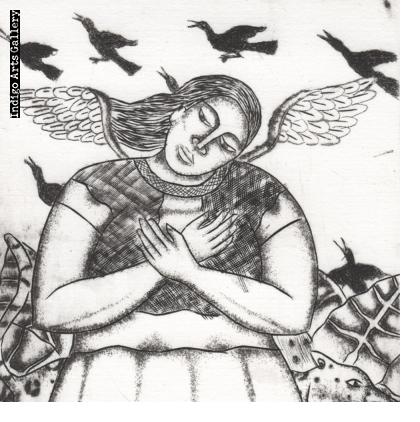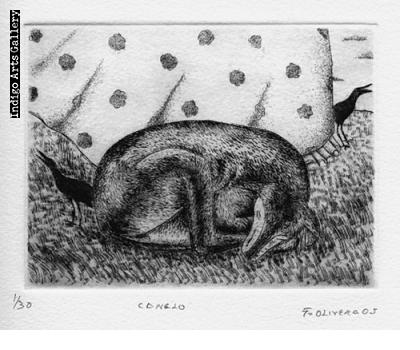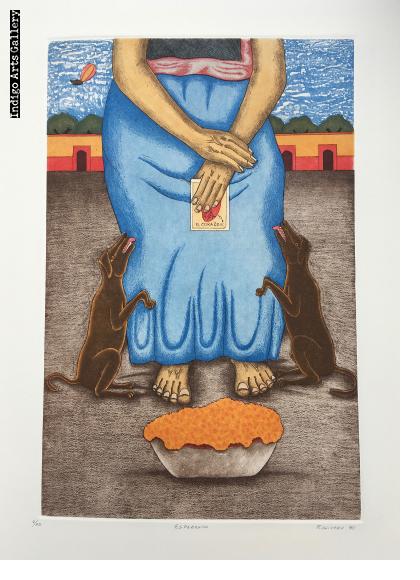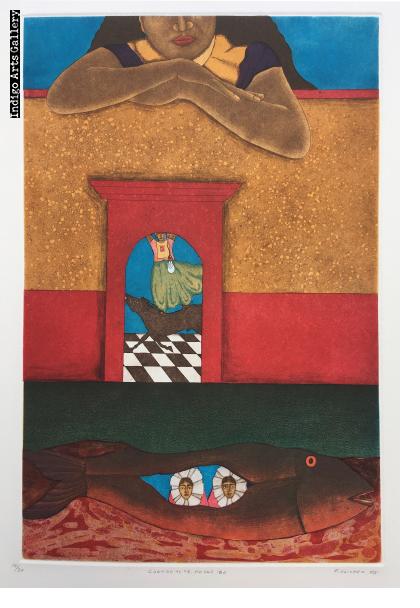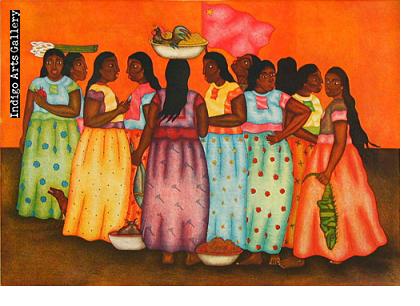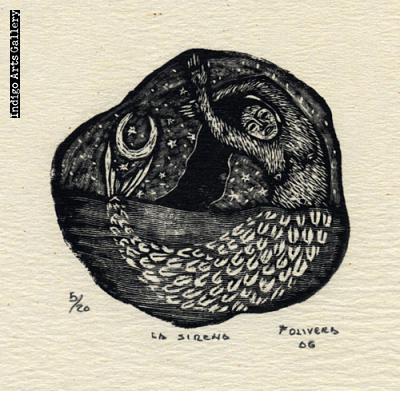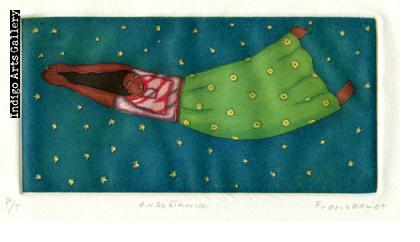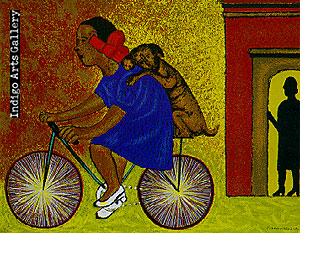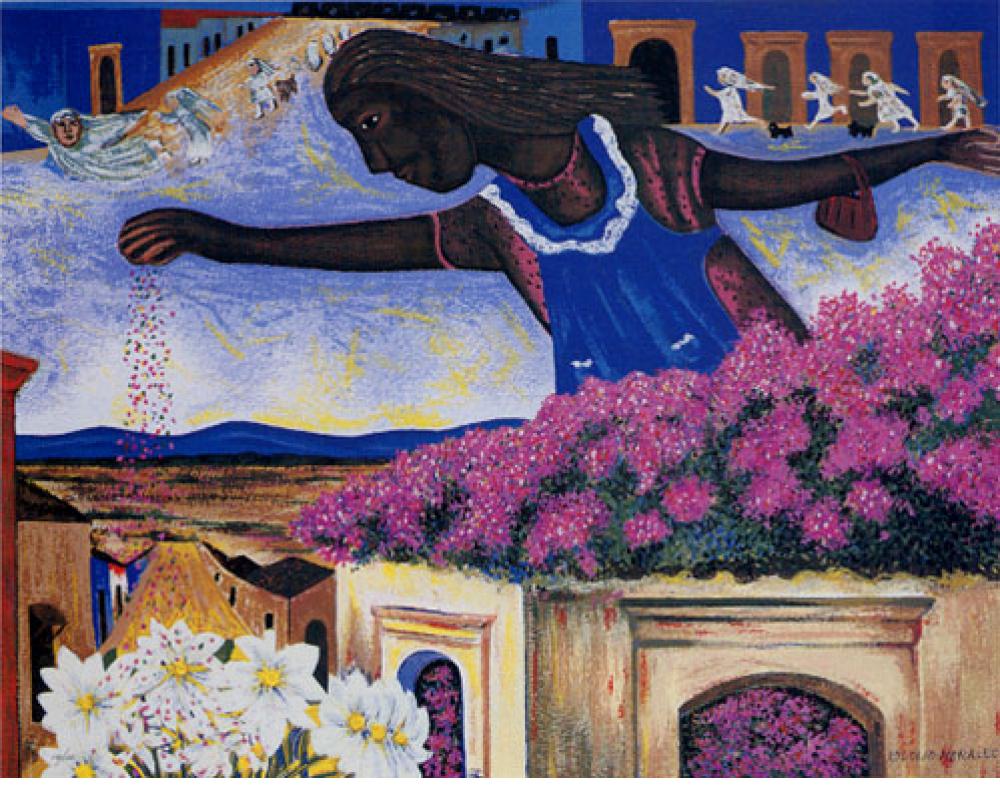
Indigo Arts’ show of prints from Oaxaca is selected from the summer’s exhibition of prints and paintings, De la Tierra de los Sueños / From the Land of Dreams. Dating from 1986 to the present, the Oaxacan prints bring the story of Mexican printmaking up to the present.. While the landscape, customs, mythology and political struggles they depict are specific to Oaxaca of the last two decades, the work carries on the great Mexican print-making tradition that runs from Guadalupe Posada through Rivera, Orozco, Siqueiros and Tamayo.
In twenty years of exhibiting the artists of Oaxaca, Mexico the owners of Indigo Arts Gallery have seen Oaxaca grow into the most vibrant regional art center in Mexico. The mountainous southern Mexico state has long been known as a center for folk art production, including its famous black pottery, weavings, and carved wooden animals. Oaxaca has also produced three of the leading masters of 20th century Mexican art; the late Rufino Tamayo and Rodolfo Morales and the still very active Francisco Toledo. But it is the vitality of the younger generation of Oaxaca artists inspired and nurtured by these masters, that has led critics to identify a distinct Oaxaca School of Mexican art. Oaxacan art draws its strength from native Indian culture, myths and legends. It is suffused with “magic realism” a folk surrealism in which people fly and mysterious juxtapositions are the norm. As poet Alberto Blanco has written, the artists of Oaxaca “all tend to depict one theme: the appearance in our history of another time and place. A space within another space. A time within another time.”
The exhibit includes prints by a variety of contemporary artists from Oaxaca. Though influenced by all their distinguished forebears, this group of artists owes its distinct vision particularly to Rodolfo Morales, (1925-2001) deemed the “Maestro de Los Sueños” (Master of Dreams) in last year’s retrospective at the Museo de Arte Contemporaneo de Monterrey. Indigo Arts presented a solo show of Maestro Morales’ work in 1997, and a memorial show in 2001.
Modesto Bernardo is inspired by the village life and the forceful Tehuana women of the Isthmus . His black and white linocut prints manage to be at once heroic and unsentimental Born in the village of Zimatlan de Alvarez in 1963, Modesto studied at the Escuela de Bellas Artes as well as with Shinzaburo Takeda at the Taller de Artes Rufino Tamayo. His work has been exhibited in France, Japan, and in Florida, Arizona, Texas and California in the U.S.
Enrique Flores Gonzalez was born in 1963 in the village of Huitzo. He studied painting and printmaking under Juan Alcazar at the Taller Libre de Grafica, in Oaxaca. He has participated in group shows in Mexico, El Salvador, San Diego, Missoula, Philadelphia, as well as many solo shows in Mexico, Japan and the United States. In 1990 his work was included in a group show of Oaxacan artists, Life, Legend and Dreams, which opened at the University of Arizona Art Museum of Art in Tucson and toured to the Heard Museum in Phoenix, as well to California. His work is in such public collections as the University of Arizona Museum and the Nelson Center for the Arts at Arizona State University. He illustrated the 1995 book, The Harvest Birds, for Children’s Book Press.
Alone among this group of artists, Abelardo Lopez (born in 1957) concentrates on the landscape of Oaxaca in his work. Lopez studied at the Escuela de Bellas Artes of the Benito Juarez University in Oaxaca and was a founding member of the Taller de Artes Rufino Tamayo. His work was included in the show “Seven Artists from Oaxaca” at the Museum of Latin American Art in Washington D.C., as well as shows throughout Mexico.
José Eddie Martinez is from Juchitan in the hot, lowland Isthmus of Tehuantepec region of Oaxaca, where he was born in 1963. He studied at the Taller de Artes Plasticas Rufino Tamayo under Roberto Donis, and continued his studies with Juan Alcazar at the Taller Libre de la Grafica Oaxaquena. Eddie Martinez’s enigmatic and often dark prints and paintings have been featured in several solo shows in Oaxaca, as well as group shows in both the United States and Mexico, such as the touring Life, Legend and Dreams show in 1990. His work is included in such public collections as the Museo de Arte Contemporaneo Latino Americano in Uruguay, and the Nelson Center for the Arts at Arizona State Univesity.
Leovigildo Martinez was born in the city of Oaxaca in 1959. He began his studies in 1977 at the Centro de Educacion Artistico de Oaxaca, and studied at the Taller de Artes Rufino Tamayo as well. He has been included in a number of group shows since 1977, including the Life, Legends and Dreams show. A visit to California in 1987 led to a series of solo shows in Los Altos, Santa Clara and San Francisco. He has illustrated several children’s books, including The Twenty-five Mixtec Cats, and The Moon Was at a Fiesta by Matthew Gollub. The Cafe Pasqual’s Cookbook featured the murals he painted in that celebrated Santa Fe restaurant.
Felipe Morales was born in 1959 near Ocotlan, Oaxaca. A self-taught artist, he later studied at the Taller de Artes Plasticas Rufino Tamayo. He works in ceramics as well as painting and print-making. His exhibitions have included Cuatro Artistas de Oaxaca, at the Museo Carillo Gil, Mexico City (1983), Contemporary Art of Mexico, Mexican Fine Art Center Museum, Chicago (1988), Oaxaca, Magia en Mexico (1993), Myth and Magic - Oaxaca, Past and Present (1994), at the Palo Alto Cultural Center, Felipe Morales - Uno de Oaxaca (2004), in Brownsville, Texas, as well as many solo exhibitions in Oaxaca.
Fernando Olivera was born in the city of Oaxaca in 1962. He studied art at the Escuela de Bellas Artes at the Benito Juarez University in Oaxaca. He went on to study lithography with Japanese-born print-maker Shinzaburo Takeda at the Taller de Artes Rufino Tamayo. In addition to many solo shows in Mexico, Olivera has participated in group shows in Mexico City, El Salvador, Montana, San Francisco, Palo Alto, Chicago and Philadelphia (including seven group or solo shows at Indigo Arts). He illustrated the children’s book, The Woman Who Outshone the Sun, based on a Mixtec folk tale, published by Children’s Book Press in California. Olivera’s work was included in the 1994 show Myth & Magic: Oaxaca Past and Present organized by the Palo Alto Cultural Center, as well as the book of the same name. His work was also included in The Tree is Older than You Are, a 1995 collection of Mexican poems and stories published by Simon and Schuster.
Olivera’s vision is grounded in the traditional life of Oaxaca and the myths and legends of its people. In works such as “Lagarto”, “El Viento nos Llevara” and “Tarde de Mayo” (Afternoon in May), the everyday seems to merge seamlessly with the mythical and even surreal. Like Frida Kahlo before him, Olivera is inspired by the legendary Tehuana women of the Isthmus of Tehuantepec, and features them in many of these works. Olivera’s work also reflects his social and political concerns. Over the years he has returned repeatedly to the peasant struggles in the Tehuana city of Juchitan, and for the last decade much of his work has been preoccupied with the uprising in the southern state of Chiapas, led by the Zapatista Liberation Front. In “Jaguar de Luz” and “Los Ojos de la Selva” (The eyes of the forest) masked Zapatistas peer out of the forest. In “Requiem por los Caidos”, a Tehuana-dressed angel mourns for those who died in the conflict.
Filemon Santiago, was born in San José Sosala, Oaxaca in 1959. A self- taught artist, Santiago exhibited his work widely in Mexico before moving to the United States in the late 70’s. He lived and worked for 12 years in Chicago before returning to his native Oaxaca. During thise years he showed his work in Washington DC, New York, Rotterdam, Holland as well as galleries and museums in Chicago. His work is included in the collections of the Art Institute of Chicago, Museum of Modern Art of Latin America in Washington, DC, the Illinois State Museum, and the Harold Washington Library in Chicago, as well as major corporate collections.

